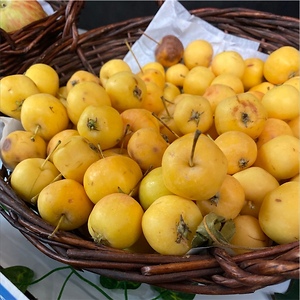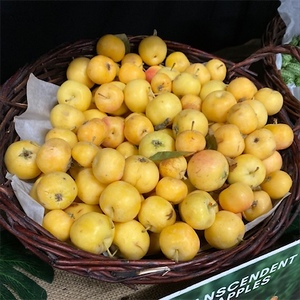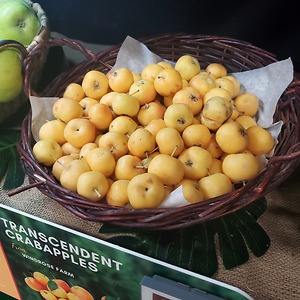


Transcendent Crabapples
Estimated Inventory, lb : 0
This item was last sold on : 11/10/23
Description/Taste
Transcendent crabapples are small in size, averaging 3 to 5 centimeters in diameter, and have a round to oblate shape with ribbing, creating angular faces on the surface. The crabapple’s stem is long, slender, and dark brown to tan, connecting to the fruits through a narrow cavity. The skin is thin, smooth, and taut, occasionally covered in a faint bloom that can be easily wiped away. The surface also ripens from green to a vibrant golden yellow, sometimes orange hue. Underneath the skin, the yellow flesh is solid, aqueous, and fine-grained with a crisp, crunchy, and succulent consistency. The flesh also encases a small central core filled with tiny dark brown seeds. Transcendent crabapples are edible raw and are a variety with a more balanced taste, unlike other crabapple cultivars known for their unpalatable nature. When ripe, Transcendent crabapples have a sweet-tart flavor with a subtly astringent aftertaste.
Seasons/Availability
Transcendent crabapples are available in the late summer through fall, with peak harvest from August through September.
Current Facts
Transcendent crabapples, botanically classified as Malus baccata, are an American variety belonging to the Rosaceae family. The heirloom variety is thought to be a type of Siberian crabapple that was first recorded in the late 19th century in New York. Transcendent crabapples are one of the largest varieties of Siberian crabapples and grow on trees reaching 3 to 6 meters in height. Growers favor Transcendent crabapples for their productive, easy-to-grow nature, cold tolerance, and ability to remain on the tree for extended periods. The trees bear fruit approximately 2 to 3 years after planting, and the variety is valued for its ornamental pink and white blooms in addition to its golden fruits. In the modern day, Transcendent crabapples are primarily grown in specialty and home gardens and are a seasonal fruit utilized in ciders and sweet or savory culinary preparations. The cultivar also has a more balanced flavor than other varieties, allowing it to be consumed raw if desired.
Nutritional Value
Transcendent crabapples are a source of magnesium to control nerve functioning, iron to develop the protein hemoglobin for oxygen transport through the bloodstream, and vitamin C to boost the immune system. The variety also provides fiber to regulate the digestive tract, potassium to balance fluid levels within the body, calcium to build strong bones and teeth, and other nutrients, including copper, phosphorus, B vitamins, and manganese. It is important to note that the nutritional content of crabapples is low as the fruits are small in size, and many crabapples would have to be ingested to acquire substantial nutrients.
Applications
Transcendent crabapples have a balanced, sweet, and tart taste suited for fresh and cooked preparations. The fruits can be eaten out of hand, but some consumers may not appreciate their subtle astringency when raw. Transcendent crabapples are most popularly simmered into jams, jellies, and preserves. The variety is a natural source of pectin and requires no additional pectin added to thicken preserves. In addition to jellies, Transcendent crabapples can be canned or infused into a syrup, drizzled over waffles, pancakes, smoothie bowls, and porridge. The syrup can also be cooked into a glaze and poured over meat dishes such as duck or pork. Try cooking Transcendent crabapples into applesauce or baking the fruits into pies, cakes, bars, or tarts. Beyond cooked preparations, Transcendent crabapples were customarily used in cider throughout the 20th century in the United States. Transcendent crabapples pair well with spices such as ginger, nutmeg, cloves, and cinnamon, brown sugar, honey, maple syrup, vanilla, herbs including thyme, cloves, and mint, and fruits such as quince, rowanberries, raspberries, and blackberries. Whole, unwashed Transcendent crabapples will keep for 1 to 2 weeks when stored in the refrigerator’s crisper drawer. It is recommended to immediately consume the fruit for the best quality and flavor, as the variety has a notoriously short shelf life.
Ethnic/Cultural Info
Transcendent apples were named for their distinct characteristics, including their large size as a crabapple, unblemished skin, and balanced flavor. These qualities earned them their transcendent moniker, a descriptor defined as something beyond the ordinary or exceptional. American growers also have commented throughout history that the crabapples almost appear as if they are glowing when hanging on the tree in the afternoon sun due to their yellow-orange skin, giving them an ethereal reputation. Transcendent apples were among the most popular crabapples in the northeastern United States in the 20th century. During this time, the variety was typically used for jellies, ciders, and various celebratory drinks. One drink, known as Lamb’s Wool, a traditional English beverage that dates back to the 13th century, was often made in the fall during harvest celebrations and was adapted to various uses throughout the colonies. The drink was comprised of dark beer, ale, or cider, and roasted crabapples were dropped into the chilled beverages, creating a popping and hissing sound as the crabapples burst, creating a “wooly” texture at the top of the drink.
Geography/History
Transcendent crabapples are native to the United States and were first mentioned in the William R. Prince & Co. Catalogue in 1844. William R. Prince & Co. was one of the first large-scale commercial nurseries in the United States based in Flushing, New York. The parentage and history of Transcendent crabapples is unknown, but the variety is thought to be a type of Siberian crabapple and may be older than its first mention in 1844, making the cultivar a significant North American heirloom. In 1875, over 2,000 Transcendent crabapple trees were planted at Pine Grove Farm, a commercial orchard in Stevensville, Montana, marking the expansion of the variety’s presence into the Western United States. Transcendent crabapples became one of the most popular crabapples in the United States in the 20th century and were planted in commercial orchards and home gardens as an ornamental and culinary cultivar. Respected plant breeder Albert Etter also used Transcendent crabapples in apple breeding, creating Etter’s Gold, Eden Crab, and possibly the Wickson crabapples from Transcendent parentage. Today, Transcendent crabapples are cultivated throughout the United States and have expanded into regions of Canada. The variety is not well-known outside gardening communities, but the fruits are seasonal delicacies sold directly through growers and farmer’s markets.










